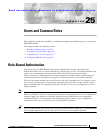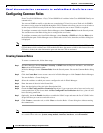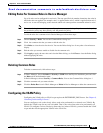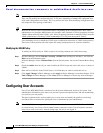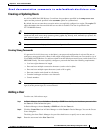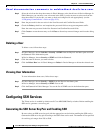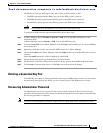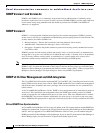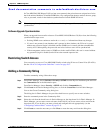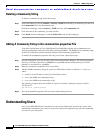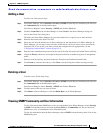
Send documentation comments to mdsfeedback-doc@cisco.com.
25-6
Cisco MDS 9000 Family Fabric Manager Configuration Guide
OL-6965-03, Cisco MDS SAN-OS Release 2.x
Chapter 25 Users and Common Roles
Configuring SSH Services
Step 4 Select the role from the drop-down menu in Fabric Manager or the check boxes in Device Manager. In
Fabric Manager, you can enter a new role name in the field if you do not want to select one from the
drop-down menu. If you do this, you must go back and configure this role appropriately (see the
“Configuring Common Roles” section on page 25-2).
Step 5 Enter the password for the user twice in the New Password and Confirm Password fields.
Step 6 Check the Privacy check box and complete the password fields to encrypt management traffic.
Enter the same new password in the New Password and Confirm Password fields.
Step 7 Click Create to create the new entry or click Close to discard any unsaved changes and close the dialog
box.
Deleting a User
To delete a user, follow these steps:
Step 1 In Fabric Manager, choose Switches > Security > SNMP from the Physical Attributes pane and click
the Users tab in the Information pane.
In Device Manager, choose Security > SNMP and click the Users tab.
Step 2 Click the name of the user you want to delete.
Step 3 Click the Delete Row icon in Fabric Manager or Delete in Device Manager to delete the selected user.
Viewing User Information
To view information about users, follow these steps:
Step 1 In Fabric Manager, choose Security > SNMP from the Physical Attributes pane.
In Device Manager, choose Security > SNMP. You see the
Step 2 Click the Users tab in Fabric Manager. You see the list of SNMP users in the Information pane.
Configuring SSH Services
The Telnet service is enabled by default on all Cisco MDS 9000 Family switches. Before enabling the
SSH service, generate a server key pair.
Generating the SSH Server Key Pair and Enabling SSH
Be sure to have an SSH server key pair with the appropriate version before enabling the SSH service.
Generate the SSH server key pair according to the SSH client version used. The number of bits specified
for each key pair ranges from 768 to 2048.






